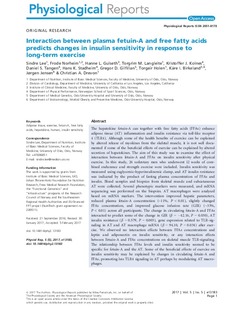| dc.description.abstract | The hepatokine fetuin‐A can together with free fatty acids (FFAs) enhance adipose tissue (AT) inflammation and insulin resistance via toll‐like receptor 4 (TLR4). Although some of the health benefits of exercise can be explained by altered release of myokines from the skeletal muscle, it is not well documented if some of the beneficial effects of exercise can be explained by altered secretion of hepatokines. The aim of this study was to examine the effect of interaction between fetuin‐A and FFAs on insulin sensitivity after physical exercise. In this study, 26 sedentary men who underwent 12 weeks of combined endurance and strength exercise were included. Insulin sensitivity was measured using euglycemic‐hyperinsulinemic clamp, and AT insulin resistance was indicated by the product of fasting plasma concentration of FFAs and insulin. Blood samples and biopsies from skeletal muscle and subcutaneous AT were collected. Several phenotypic markers were measured, and mRNA sequencing was performed on the biopsies. AT macrophages were analyzed based on mRNA markers. The intervention improved hepatic parameters, reduced plasma fetuin‐A concentration (~11%, P < 0.01), slightly changed FFAs concentration, and improved glucose infusion rate (GIR) (~33%, P < 0.01) across all participants. The change in circulating fetuin‐A and FFAs interacted to predict some of the change in GIR (β = −42.16, P = 0.030), AT insulin resistance (β = 0.579, P = 0.003), gene expression related to TLR‐signaling in AT and AT macrophage mRNA (β = 94.10, P = 0.034) after exercise. We observed no interaction effects between FFAs concentrations and leptin and adiponectin on insulin sensitivity, or any interaction effects between Fetuin‐A and FFAs concentrations on skeletal muscle TLR‐signaling. The relationship between FFAs levels and insulin sensitivity seemed to be specific for fetuin‐A and the AT. Some of the beneficial effects of exercise on insulin sensitivity may be explained by changes in circulating fetuin‐A and FFAs, promoting less TLR4 signaling in AT perhaps by modulating AT macrophages. | nb_NO |
